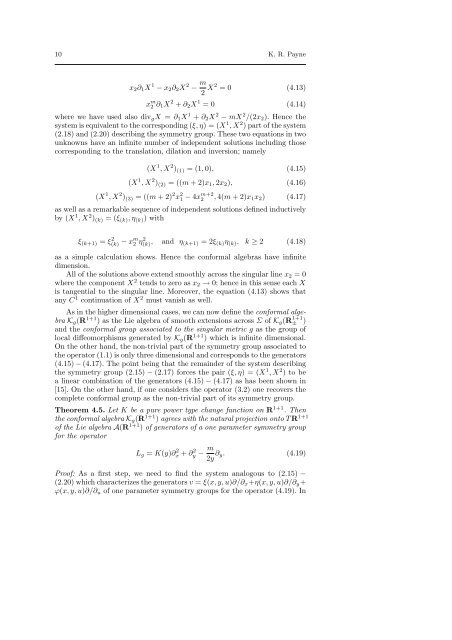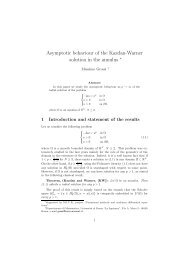Singular metrics and associated conformal groups underlying ...
Singular metrics and associated conformal groups underlying ...
Singular metrics and associated conformal groups underlying ...
Create successful ePaper yourself
Turn your PDF publications into a flip-book with our unique Google optimized e-Paper software.
10 K. R. Payne<br />
x2∂1X 1 − x2∂2X 2 − m<br />
2 X2 = 0 (4.13)<br />
x m 2 ∂1X 2 + ∂2X 1 = 0 (4.14)<br />
where we have used also divgX = ∂1X 1 + ∂2X 2 − mX 2 /(2x2). Hence the<br />
system is equivalent to the corresponding (ξ, η) = (X 1 , X 2 ) part of the system<br />
(2.18) <strong>and</strong> (2.20) describing the symmetry group. These two equations in two<br />
unknowns have an infinite number of independent solutions including those<br />
corresponding to the translation, dilation <strong>and</strong> inversion; namely<br />
(X 1 , X 2 ) (1) = (1, 0), (4.15)<br />
(X 1 , X 2 ) (2) = ((m + 2)x1, 2x2), (4.16)<br />
(X 1 , X 2 ) (3) = ((m + 2) 2 x 2 1 − 4x m+2<br />
2 , 4(m + 2)x1x2) (4.17)<br />
as well as a remarkable sequence of independent solutions defined inductively<br />
by (X 1 , X 2 ) (k) = (ξ (k), η (k)) with<br />
ξ (k+1) = ξ 2 (k) − xm 2 η 2 (k) , <strong>and</strong> η (k+1) = 2ξ (k)η (k), k ≥ 2 (4.18)<br />
as a simple calculation shows. Hence the <strong>conformal</strong> algebras have infinite<br />
dimension.<br />
All of the solutions above extend smoothly across the singular line x2 = 0<br />
where the component X 2 tends to zero as x2 → 0; hence in this sense each X<br />
is tangential to the singular line. Moreover, the equation (4.13) shows that<br />
any C 1 continuation of X 2 must vanish as well.<br />
As in the higher dimensional cases, we can now define the <strong>conformal</strong> algebra<br />
Kg(R1+1 ) as the Lie algebra of smooth extensions across Σ of Kg(R 1+1<br />
± )<br />
<strong>and</strong> the <strong>conformal</strong> group <strong>associated</strong> to the singular metric g as the group of<br />
local diffeomorphisms generated by Kg(R1+1 ) which is infinite dimensional.<br />
On the other h<strong>and</strong>, the non-trivial part of the symmetry group <strong>associated</strong> to<br />
the operator (1.1) is only three dimensional <strong>and</strong> corresponds to the generators<br />
(4.15) − (4.17). The point being that the remainder of the system describing<br />
the symmetry group (2.15) − (2.17) forces the pair (ξ, η) = (X1 , X2 ) to be<br />
a linear combination of the generators (4.15) − (4.17) as has been shown in<br />
[15]. On the other h<strong>and</strong>, if one considers the operator (3.2) one recovers the<br />
complete <strong>conformal</strong> group as the non-trivial part of its symmetry group.<br />
Theorem 4.5. Let K be a pure power type change function on R 1+1 . Then<br />
the <strong>conformal</strong> algebra Kg(R 1+1 ) agrees with the natural projection onto T R 1+1<br />
of the Lie algebra A(R 1+1 ) of generators of a one parameter symmetry group<br />
for the operator<br />
Lg = K(y)∂ 2 x + ∂ 2 y − m<br />
2y ∂y. (4.19)<br />
Proof: As a first step, we need to find the system analogous to (2.15) −<br />
(2.20) which characterizes the generators v = ξ(x, y, u)∂/∂x+η(x, y, u)∂/∂y+<br />
ϕ(x, y, u)∂/∂u of one parameter symmetry <strong>groups</strong> for the operator (4.19). In








